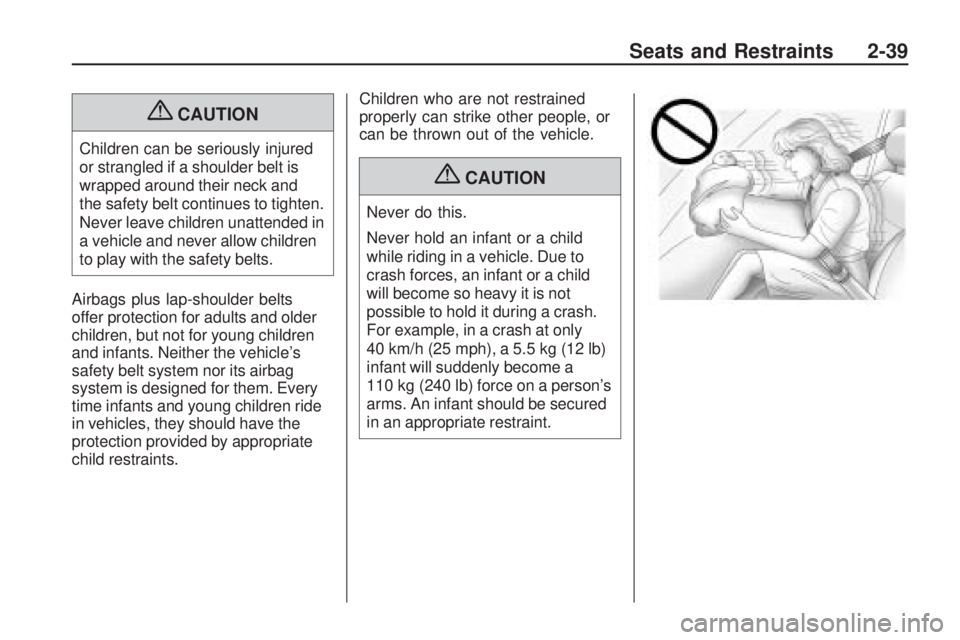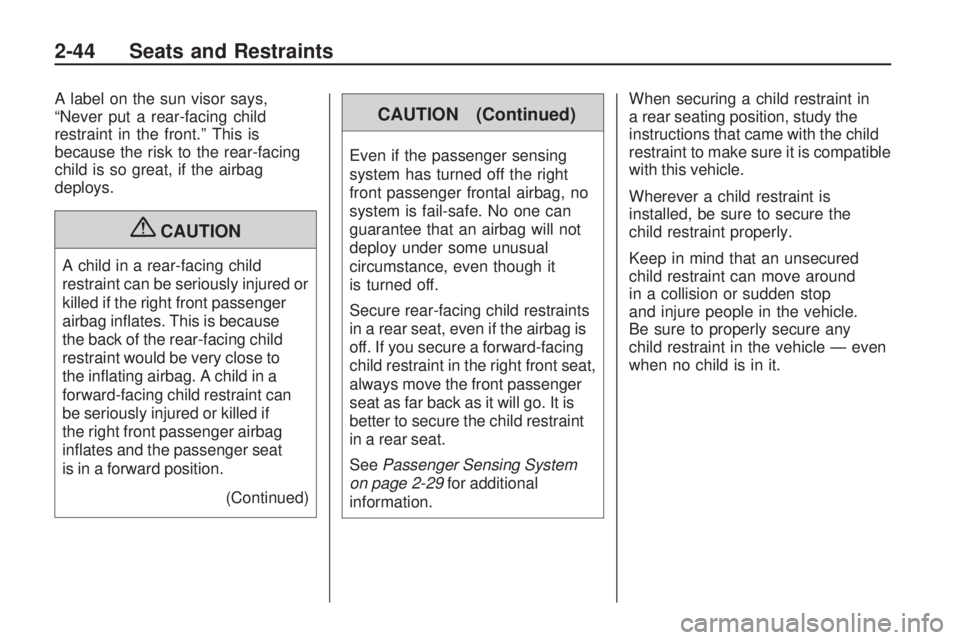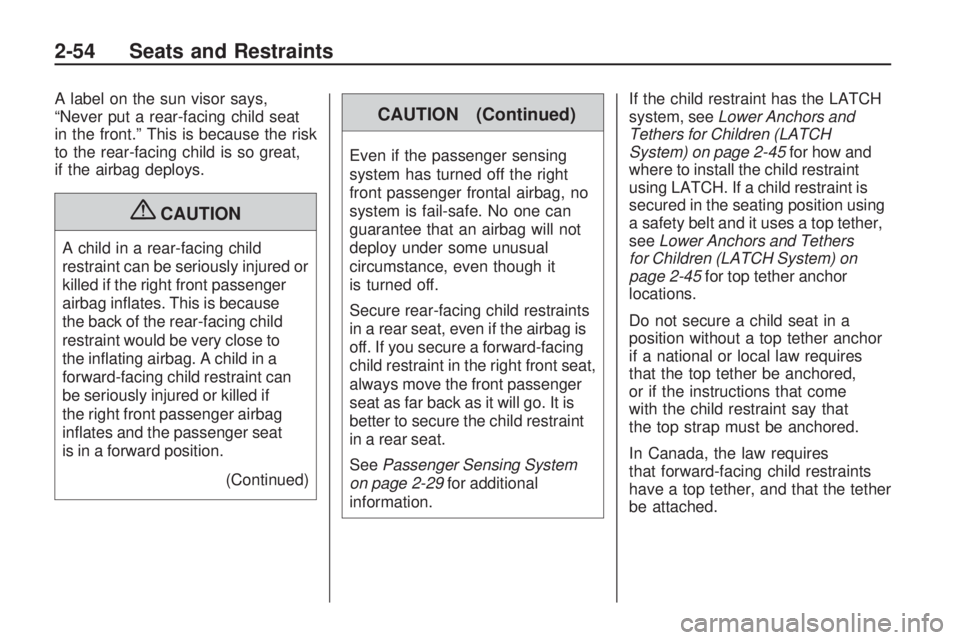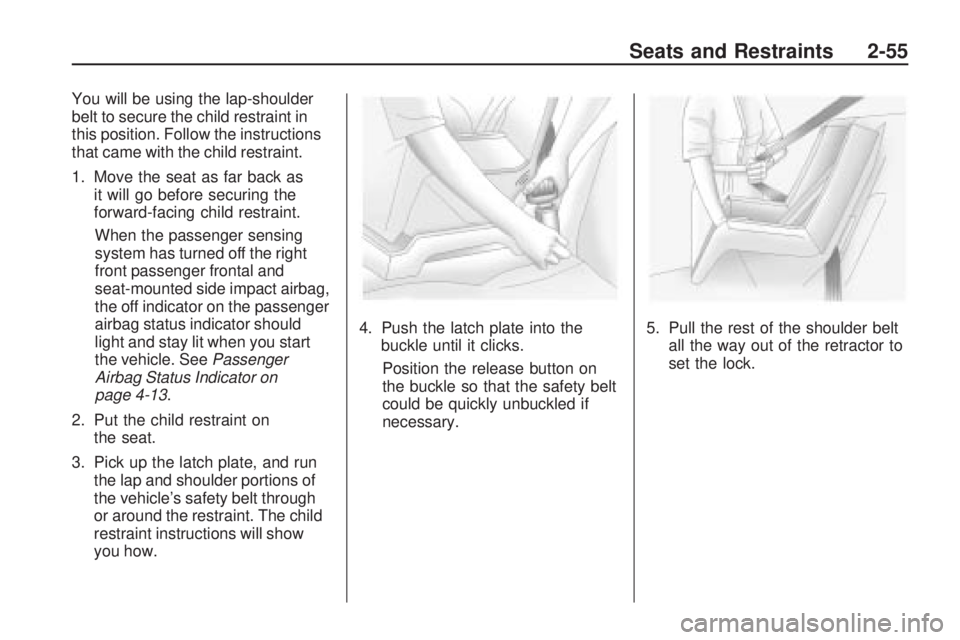2010 PONTIAC VIBE airbag off
[x] Cancel search: airbag offPage 54 of 318

The passenger sensing system may
suppress the airbag deployment
when liquid soaks into the seat.
If this happens, the off indicator
in the passenger airbag status
indicator and the airbag readiness
light will be lit. Have your
dealer/retailer check the system.
An object, person or child in the
rear seat contacting or pressing
the right front passenger seatback,
or objects stowed under the right
front passenger seat, may affect the
proper functioning of the passenger
sensing system.
When a safety belt extender is
used in the right front passenger
seat, make sure the passenger
airbag status indicator shows
ON. If the indicator shows OFF,
disconnect the extender’s latch fromthe buckle then reconnect the safety
belt. The passenger airbag status
indicator light should be ON and
then the safety belt extender can
be reconnected. If the safety belt
extender is used while the passenger
airbag status indicator light is OFF,
the right front passenger frontal and
seat-mounted side impact airbags (if
equipped) may not activate correctly.
{CAUTION
Stowing of articles under the
passenger seat or between the
passenger seat cushion and
seatback may interfere with the
proper operation of the passenger
sensing system.
Servicing the
Airbag-Equipped Vehicle
Airbags affect how the vehicle
should be serviced. There are
parts of the airbag system in
several places around the vehicle.
Your dealer/retailer and the service
manual have information about
servicing the vehicle and the airbag
system. To purchase a service
manual, see
Service Publications
Ordering Information on page 12-12 .
{CAUTION
For up to 10 seconds after the
ignition is turned off and the
battery is disconnected, an airbag
can still inflate during improper
service. You can be injured if you
are close to an airbag when it
inflates. Avoid yellow connectors.
They are probably part of the
airbag system. Be sure to follow
proper service procedures, and
make sure the person performing
work for you is qualified to do so.
2-34 Seats and Restraints
Page 55 of 318

Adding Equipment to the
Airbag-Equipped
Vehicle
Q:Is there anything I might add
to or change about the vehicle
that could keep the airbags
from working properly?
A:Yes. If you add things that
change the vehicle’s frame,
bumper system, height, front end
or side sheet metal, they may
keep the airbag system from
working properly. Changing or
moving any parts of the front
seats, safety belts, the airbag
sensing and diagnostic module,
steering wheel, instrument panel,
roof-rail airbag modules, ceiling
headliner or pillar garnish trim,
front sensors, side impact
sensors, or airbag wiring can
affect the operation of the airbag
system.
In addition, the vehicle has a
passenger sensing system for
the right front passenger position, which includes sensors that
are part of the passenger seat.
The passenger sensing system
may not operate properly if the
original seat trim is replaced
with non-GM covers, upholstery
or trim, or with GM covers,
upholstery or trim designed for a
different vehicle. Any object, such
as an aftermarket seat heater or a
comfort enhancing pad or device,
installed under or on top of the
seat fabric, could also interfere
with the operation of the
passenger sensing system.
This could either prevent proper
deployment of the passenger
airbag(s) or prevent the
passenger sensing system from
properly turning off the passenger
airbag(s). See
Passenger
Sensing System on page 2-29 .
If you have questions, call
Customer Assistance. The phone
numbers and addresses for Customer Assistance are in
Step Two of the Customer
Satisfaction Procedure in
this manual. See
Customer
Satisfaction Procedure on
page 12-1.
Q:Because I have a disability,
I have to get my vehicle
modi�ed. How can I �nd out
whether this will affect my
airbag system?
A:If you have questions, call
Customer Assistance. The phone
numbers and addresses for
Customer Assistance are in
Step Two of the Customer
Satisfaction Procedure in
this manual. See Customer
Satisfaction Procedure on
page 12-1.
In addition, your dealer/retailer and
the service manual have information
about the location of the airbag
sensors, sensing and diagnostic
module and airbag wiring.
Seats and Restraints 2-35
Page 59 of 318

{CAUTION
Children can be seriously injured
or strangled if a shoulder belt is
wrapped around their neck and
the safety belt continues to tighten.
Never leave children unattended in
a vehicle and never allow children
to play with the safety belts.
Airbags plus lap-shoulder belts
offer protection for adults and older
children, but not for young children
and infants. Neither the vehicle’s
safety belt system nor its airbag
system is designed for them. Every
time infants and young children ride
in vehicles, they should have the
protection provided by appropriate
child restraints. Children who are not restrained
properly can strike other people, or
can be thrown out of the vehicle.
{CAUTION
Never do this.
Never hold an infant or a child
while riding in a vehicle. Due to
crash forces, an infant or a child
will become so heavy it is not
possible to hold it during a crash.
For example, in a crash at only
40 km/h (25 mph), a 5.5 kg (12 lb)
infant will suddenly become a
110 kg (240 lb) force on a person’s
arms. An infant should be secured
in an appropriate restraint.
Seats and Restraints 2-39
Page 64 of 318

A label on the sun visor says,
“Never put a rear-facing child
restraint in the front.” This is
because the risk to the rear-facing
child is so great, if the airbag
deploys.
{CAUTION
A child in a rear-facing child
restraint can be seriously injured or
killed if the right front passenger
airbag inflates. This is because
the back of the rear-facing child
restraint would be very close to
the inflating airbag. A child in a
forward-facing child restraint can
be seriously injured or killed if
the right front passenger airbag
inflates and the passenger seat
is in a forward position.(Continued)
CAUTION (Continued)
Even if the passenger sensing
system has turned off the right
front passenger frontal airbag, no
system is fail-safe. No one can
guarantee that an airbag will not
deploy under some unusual
circumstance, even though it
is turned off.
Secure rear-facing child restraints
in a rear seat, even if the airbag is
off. If you secure a forward-facing
child restraint in the right front seat,
always move the front passenger
seat as far back as it will go. It is
better to secure the child restraint
in a rear seat.
SeePassenger Sensing System
on page 2-29 for additional
information. When securing a child restraint in
a rear seating position, study the
instructions that came with the child
restraint to make sure it is compatible
with this vehicle.
Wherever a child restraint is
installed, be sure to secure the
child restraint properly.
Keep in mind that an unsecured
child restraint can move around
in a collision or sudden stop
and injure people in the vehicle.
Be sure to properly secure any
child restraint in the vehicle — even
when no child is in it.
2-44 Seats and Restraints
Page 73 of 318

5. To tighten the belt, push downon the child restraint, pull the
shoulder portion of the belt to
tighten the lap portion of the belt,
and feed the shoulder belt back
into the retractor. When installing
a forward-facing child restraint, it
may be helpful to use your knee
to push down on the child
restraint as you tighten the belt. 6. If the child restraint has a top
tether, follow the child restraint
manufacturer’s instructions
regarding the use of the top
tether. See Lower Anchors and
Tethers for Children (LATCH
System) on page 2-45 for more
information.
7. Push and pull the child restraint in different directions to be sure
it is secure.
To remove the child restraint,
unbuckle the vehicle safety belt and
let it return to the stowed position.
If the top tether is attached to a top
tether anchor, disconnect it.
Securing Child Restraints
(Right Front Seat
Position)
This vehicle has airbags. A rear
seat is a safer place to secure
a forward-facing child restraint.
See Where to Put the Restraint
on page 2-43.
In addition, the vehicle has a
passenger sensing system which is
designed to turn off the right front
passenger frontal and seat-mounted
side impact airbag under certain
conditions. See Passenger Sensing
System on page 2-29 andPassenger
Airbag Status Indicator on page 4-13
for more information, including
important safety information.
Seats and Restraints 2-53
Page 74 of 318

A label on the sun visor says,
“Never put a rear-facing child seat
in the front.” This is because the risk
to the rear-facing child is so great,
if the airbag deploys.
{CAUTION
A child in a rear-facing child
restraint can be seriously injured or
killed if the right front passenger
airbag inflates. This is because
the back of the rear-facing child
restraint would be very close to
the inflating airbag. A child in a
forward-facing child restraint can
be seriously injured or killed if
the right front passenger airbag
inflates and the passenger seat
is in a forward position.(Continued)
CAUTION (Continued)
Even if the passenger sensing
system has turned off the right
front passenger frontal airbag, no
system is fail-safe. No one can
guarantee that an airbag will not
deploy under some unusual
circumstance, even though it
is turned off.
Secure rear-facing child restraints
in a rear seat, even if the airbag is
off. If you secure a forward-facing
child restraint in the right front seat,
always move the front passenger
seat as far back as it will go. It is
better to secure the child restraint
in a rear seat.
SeePassenger Sensing System
on page 2-29 for additional
information. If the child restraint has the LATCH
system, see
Lower Anchors and
Tethers for Children (LATCH
System) on page 2-45 for how and
where to install the child restraint
using LATCH. If a child restraint is
secured in the seating position using
a safety belt and it uses a top tether,
see Lower Anchors and Tethers
for Children (LATCH System) on
page 2-45 for top tether anchor
locations.
Do not secure a child seat in a
position without a top tether anchor
if a national or local law requires
that the top tether be anchored,
or if the instructions that come
with the child restraint say that
the top strap must be anchored.
In Canada, the law requires
that forward-facing child restraints
have a top tether, and that the tether
be attached.
2-54 Seats and Restraints
Page 75 of 318

You will be using the lap-shoulder
belt to secure the child restraint in
this position. Follow the instructions
that came with the child restraint.
1. Move the seat as far back asit will go before securing the
forward-facing child restraint.
When the passenger sensing
system has turned off the right
front passenger frontal and
seat-mounted side impact airbag,
the off indicator on the passenger
airbag status indicator should
light and stay lit when you start
the vehicle. See Passenger
Airbag Status Indicator on
page 4-13.
2. Put the child restraint on the seat.
3. Pick up the latch plate, and run the lap and shoulder portions of
the vehicle’s safety belt through
or around the restraint. The child
restraint instructions will show
you how. 4. Push the latch plate into the
buckle until it clicks.
Position the release button on
the buckle so that the safety belt
could be quickly unbuckled if
necessary. 5. Pull the rest of the shoulder belt
all the way out of the retractor to
set the lock.
Seats and Restraints 2-55
Page 76 of 318

6. To tighten the belt, push downon the child restraint, pull the
shoulder portion of the belt to
tighten the lap portion of the belt
and feed the shoulder belt back
into the retractor. When installing
a forward-facing child restraint,
it may be helpful to use your
knee to push down on the child
restraint as you tighten the belt.
7. Push and pull the child restraint in different directions to be sure
it is secure. If the airbags are off, the off
indicator in the passenger airbag
status indicator will come on
and stay on when the vehicle
is started.
If a child restraint has been
installed and the on indicator is lit,
see “If the On Indicator is Lit for a
Child Restraint” under
Passenger
Sensing System on page 2-29 for
more information.
To remove the child restraint,
unbuckle the vehicle safety belt and
let it return to the stowed position.
2-56 Seats and Restraints